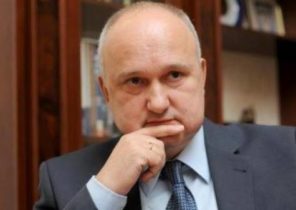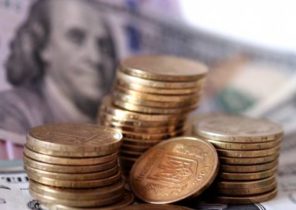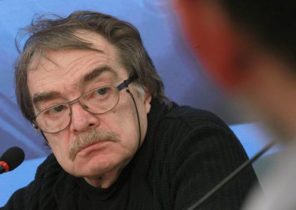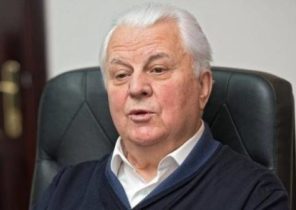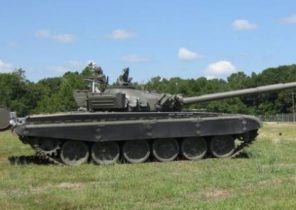
Three years after the beginning of the conflict between Kiev and the separatist Donbass, apparently, was never found no solution. The President of Ukraine Petro Poroshenko rushes from one extreme to the other, torn between the imposition of blockade and recovery of controlled economic ties. At the same time, in the Donbass the population is organized in anticipation of a hypothetical military intervention.
“They fired at the house in the night from 3 to 4 February, but we’ve reopened the shop this week”. Sakalauskas in a scarf and coat saleswoman tells us caused the Ukrainian army damage, and then goes to meet buyers. Her store was without Windows because of the explosions. As the entire periphery of Donetsk, Kiev district bears the fingerprints of the conflict, the Kiev authorities and separatist militias of Donbass, which unofficially supported by Moscow. Destroyed buildings and cracked fragments of the facades are reminiscent of the hardships of war, which claimed the lives of nearly 10 thousand people from April 2014. “Until the very last moment I didn’t believe that our own army can open fire on us!” — says a resident of Donetsk Alexander, working his way between the craters that dot the local streets. The more both camps there are victims, the more remote appears the prospect of returning to Donetsk and Lugansk national republics under the wing of Kiev. The same applies to the ultimate goal of the Minsk agreements that were signed in February 2015 Russia, Ukraine, France and Germany (two of the Western patron Saint of Kyiv). In addition, life in the breakaway territories of newly established with assistance of the Moscow and far from the capital.
Approved at referendum on may 11, 2014 DNR is not officially recognized by any country member of the UN, and even Russia. At the same time, “Republic”, as it is called here, every day is becoming more real. On the pediments of public buildings departments blue-and-yellow Ukrainian flag was replaced with the flag of the DNI: black-blue-red box with Russian double-headed eagle.
“Before the war there were 800 students, and now 665” — said the Director of the school № 61 in the Kiev district Andrew Udovenko. In the lobby hang photos of veterans and fallen heroes of the great Patriotic war against Nazi Germany, which adjoin the persons killed in the current conflict for young volunteers. “They are all former pupils, — says the Director. In the midst of the fighting, from 2014 to 2015, Teens studied remotely for six months. The school has come under fire. Parents and teachers voluntarily participated in its reconstruction”. “Teachers can get easy assistance from the DNR in 3 thousand hryvnias from September 2014 to April 2015 and before the war they were paid 4 thousand hryvnias. Today, the DNR pays us a salary, from 10 to 12 thousand rubles a month.”
In the center of Donetsk walk holding hands, lovers, and children ride in the parks on a tricycle. Peaceful atmosphere break is the labels “asylum” with a pointer to the walls of buildings. Suddenly there was an explosion, then another. The sounds of gunfire remind you that the front is just a few miles away. Since the beginning of the year, a growth in the number of collisions on the background of the economic blockade of the separatist regions from Kiev. In winter, the epicenter of the tension was the water treatment plant in Yasinovataya, which was taken by the Ukrainian army on February 27. The station supplies water to the settlements on both sides of the contact line.
Approaching night, the streets are empty. Curfew for civilians is valid from 23 to 6 hours, leaving the roar of explosions, the only host city. Morning on the roads again cars and buses, erasing remembrance of yesterday’s battles. At lunch time cafes filled with students, boys and girls. His nose buried in the screens of phones, they have a rest before to go back to school.
The brain drain
“During the war took 30% of teachers and students. Then the students returned. Teachers — not all,” — says Larissa Kostrovets, rector of Donetsk Academy of management and public administration, offering us tea. He she received this position in November 2014 after the departure of her predecessor. But why the others decided to stay? “Because this is our home”, say, as something completely obvious, two students in the lecture hall.
The flight of many frames left a vacuum that resulted in the sudden appearance of newcomers in key positions in the administration. Such social mobility played into the hands of a number of people, including the current President of DNR Alexander Zakharchenko (electrician by profession). Maya Pirogov wrote articles in the press “for fun”, while “anti-terrorist operation” against Pro-Russian rebels, which launched in may 2014 came from the “revolution of dignity” the government has not turned her life around. The Director of information policy Department of the Ministry of information DND describes restoration of control over the departments during the first two years of the conflict, in particular in the field of media: “When the leadership of the local TV channel К61 (now the First national channel) ran all moved to the operators. The same thing happened with Newspapers: editors have gone, putting the publication on journalists without any salary. At first, even those they themselves carried the Newspapers to the residents, because the mail has stopped working”.
According to the Ukrainian Ministry of social policy, because of the fighting fled to a total of 1.6 million residents of Crimea and Donbas. The current population of the breakaway republics is difficult to estimate. They encompass highly urbanized areas of the region where pre-war population of 6.5 million people, and now, according to the United Nations, 2.3 million in need of humanitarian assistance.
In seeking to cope with the difficulties many have learned to live on both sides of the front. In November 2014, the Ukrainian government stopped paying pensions to residents of Crimea and uncontrolled Kiev territories, but then introduced a special procedure for displaced people. “Some retirees have registered with living on the Ukrainian side of the border relative and received two pensions from Ukraine and DNR. Now, such cases are increasingly rare, because the Ukrainian authorities have tightened control. Now every three months you need to appear in person for a pension,” says Andrew K., an employee of a construction company. Overall, from 800 thousand to one million people regularly go abroad through one of five checkpoints, which is always a crowd of many people. The daily flow is 20 to 25 thousand people. At the end of March this figure had jumped to nearly 42 thousand because of the campaign for verifying the place of residence of pensioners and recipients of social benefits.
“I’m one of the few foreigners who have it!” — laughing Spaniard Miguel Puertas (Miguel Puertas), showing the freshly printed Bank card Central national Bank, operating only in the territory of the DNI. The blogger was against the “revolution of dignity” which led to the overthrow of Pro-Russian President Viktor Yanukovych in February 2014, and moved from Lithuania to Donetsk in the summer of 2016. Now he teaches at the Donetsk national technical University. “Previously, I paid cash. Now I will be able to withdraw money in rubles or even pay for a beer at the bar with your card!”
In the current unstable atmosphere in may 2014, Ukrainian banks, who worked in Donetsk, began to close the offices, and then finally ceased its activities in all separatist territories. Those who didn’t pass on the Ukrainian side, had to use the services of “underground banks”, which took 10% of surgery. “To get cash, you had to apply to private companies: in exchange for the transfer of funds through the Internet, they gave you the amount in cash after taking commissions and withdraw money on the Ukrainian territory”, — says Andrey K.
In response, DNR has established a Central Republic Bank 7 Oct 2014. Pass through it in particular utilities, as well as pensions, which are charged in rubles. By the spring of 2015, almost 90% of all operations were in the Russian currency. In may 2015 CRH and his Luhansk colleague opened an international Bank account in South Ossetia (this is a separatist Georgian Republic was recognized in 2008 by Moscow, which probably directs its financial assistance through this channel).
Although the Kremlin does not officially recognize the independence of two breakaway republics, President Vladimir Putin has taken another step in this direction by signing on 18 February of this year a decree on the “temporary” recognition of passports, registration numbers, birth certificates and marriage certificates and others issued by the authorities of the Republic documents until the implementation of the Minsk agreements.
Russification in everyday life
Russification of the region is intertwined with everyday life: from the currency to the time zone that now corresponds to the Moscow. The same applies to schools where the Russian language now has the primary role. “At the beginning of the school year in September 2014, the Kiev government has refused to send us new textbooks. So we worked on Russian, — explains Andrew Udovenko. — We have increased the number of Russian lessons, and one of the final examinations are necessarily conducted in Russian, not Ukrainian. We have expanded the share of Russian writers in the program in literature, without having to give fully from the Ukrainian. In geography, we have added a map of Donbass”. DNR recognizes two languages, Russian and Ukrainian, although in 2015 the last almost deprived of official status. The decision about what language to learn, the child remains with the parents. “Since October 2014, the share of lessons in the Ukrainian language fell to 4% vs 15% previously. At the beginning of the 2016 school year, only one of the 80 first-graders wanted to learn the Ukrainian language. We asked him to go to a neighboring school where there is no such class,” said the Director. On the question of the possibility of reintegration of the Republic in the Ukraine, he replies: “not with the current government that is in power in Kiev.”
“The hospital people,” read the large billboards in the city centre. On the main street everywhere comes across Michael’s face Thicker, more known under the nickname “Givi”. The commander proved himself in battle for the Donetsk airport in autumn 2014 and was killed in the attack on 8 February this year. Anyway, the young “state” not only glorifies its heroes, but also forms the attributes of sovereignty. On the streets, police cars are painted in the colors of the flag of the DNI, and the stripes on the employees form. In stores on some items like pastries and cold cuts is printed “made in DPR.”
Although economic assistance to Moscow (open secret) is still critical to the operation of institutions, the new government quickly adopted measures to attract local resources. Luis Hernando muñoz (Luis Hernando Muñoz), the head of the company, which has 30 years of experience in import to Donetsk Colombian coffee, says that during the first phase of the war, from 2014 to 2015, several stores have been requisitioned to create a new network “national supermarkets” (they quickly gained popularity thanks to affordable prices). “As far as I know, the revenues from these stores were redirected to the Fund, which went to a number of things, including pensions. They became a way to stabilize the situation,” said muñoz has not spread on direct recipients and other applications of this vestige of taxation. Later, the government decided to engage with small and medium businesses. “With the summer of 2016 on businesses have tremendous pressure to ensure that they were registered and paid taxes to the Republic” — says who refused to give his name the representative of the UN development Program, who worked in Donetsk, till December of last year.
While Kyiv has not lost control, most of the mines and enterprises was officially registered in Ukraine and pay taxes there to keep access to the national market. This is especially important for the metallurgical industry, whose products (from iron ore to coal and steel) until recently went on both sides of the demarcation line. Against the background of failure of the Ukrainian government to remove the nationalists arranged the blockade, the President of DNR Alexander Zakharchenko said on March 1, on the requisition of 43 enterprises: for the most part, it was about mines and metallurgical assets of Rinat Akhmetov. This tycoon and a native of Donbass, at one time supported the separatist camp, but then moved to the side of Kiev. The owner of the holding “System Capital Management” has also lost the stadium “Donbass arena”, where he regularly handed out humanitarian assistance, collateral effects on the people of Donetsk. If you believe the data that was received by the Deputy of Parliament from the tax authorities, eight companies from the list had paid taxes in the amount of UAH 1.3 billion (EUR 45 million) per year.
From the perspective of Donetsk, the rapprochement with Moscow is not so much motivated by a nationalist impulse, as by the initiatives of Kiev, which only deepen the Gulf between him and the self-proclaimed republics. “The nationalization [of large companies] is not something good or bad, and the need to save jobs and economic activity”, — says Yana Khomenko, lecturer, Department of international Economics of Donetsk national technical University. “In the case of the blockade we need to redirect products to Russia, she explains under the approving gaze of his boss, Ludmila Shabalino. “Ukraine has forced us to respond to the blockade,” says the Director. In the beginning of the conflict in 2014, muñoz was paid 10 thousand euros for a single truck pass through the border of the national militia. After the gain control in 2015 to bring anything became impossible. Now all of its products goes through Russia legally.”
Ephemeral Donetsk-Krivoy Rog Republic
March 14, 2017, the authorities DND announced the shipment of the first cars of coal in Russia, while the Ukrainian government is negotiating on the import of anthracite from South Africa. Russia ranks sixth in the world in production of coal and needs to import it. “This is a purely political decision. Kiev wants to avoid the market breakdown in the country and create chaos on the border with Russia,” suggests Munoz. After a detour to the Russian territory of Donbass coal may be in Ukraine. The information posted on the website of Radio Liberty showed that the coal used in the metallurgical plant “Azovstal”, located not far from Mariupol to Kiev-controlled territory were transported on Russian barges. But according to local sources, it was supplied with the separatist territories.
Instead of trying to hold back the process of autonomy of the DPR, Kiev pushes it toward the East. Big Slavic neighbor offers seems to be a reasonable alternative to regain stability, while Kiev is becoming every day farther and farther from the people of Donbass. On the former regional administration building, which now houses the government of the DPR, still clearly see the shape of a Trident on the Ukrainian coat of arms, stripped of the facade. “You can learn a lot about the people looking at the monuments. This is a monument to Ukrainian poet Taras Shevchnko, next to which stands a yet larger statue of Lenin. But the most important monument is the monument to comrade Artem,” explains Puertas, leaving the audience after the lecture. The real name of the Bolshevik and revolutionary — Fedor Andreevich Sergeev. He is considered the founder of the Donetsk-Krivoy Rog Republic, which arose in the whirlwind of the October revolution in 1918. This episode of the civil war torn Ukraine apart between the troops of the red army, the troops of the Ukrainian nationalist Stepan Bender, white General Anton Denikin and the peasant insurgent army of anarchist Nestor Makhno. In the end, the territory of the Republic became part of the Ukrainian Soviet Republic in February 1919, which in turn became part of the Soviet Union in 1922. “All that’s going on here, has its roots in the distant past,” says Puertas.
